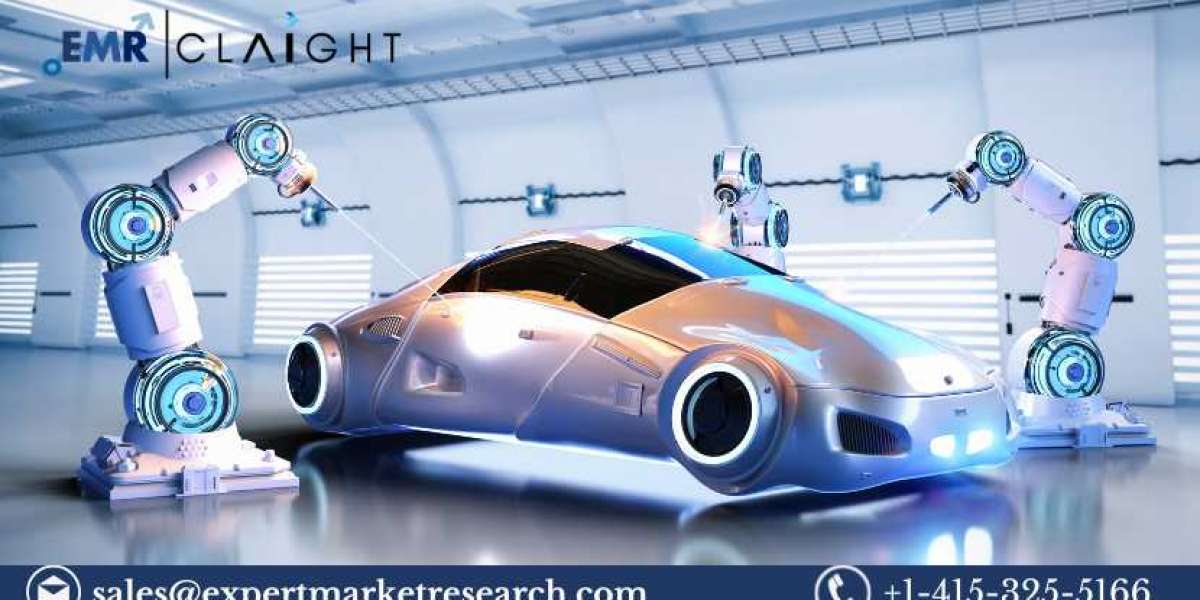The automotive robotics market has witnessed significant growth, reaching an impressive value of approximately USD 7.59 billion in 2024. This upward trajectory is set to continue with the market expected to grow at a robust compound annual growth rate (CAGR) of 10.1% during the forecast period of 2025-2034. By the end of the forecast period, the automotive robotics market is anticipated to reach nearly USD 17.96 billion. The increasing demand for automation, enhanced productivity, and cost-efficiency in the automotive industry is propelling the adoption of robotics technologies. North America is the leading region in this sector, while the Asia Pacific is emerging as the fastest-growing market.
In this article, we will explore the key aspects of the automotive robotics market, including market outlook, trends, dynamics, opportunities, challenges, and a comprehensive competitor analysis.
Automotive Robotics Market Outlook
The automotive robotics market is poised for continued growth as industries adopt automation solutions to optimize production processes. These robots play a crucial role in enhancing the efficiency of manufacturing processes, such as welding, assembly, painting, material handling, and inspection. As the demand for high-quality and precision manufacturing increases, automotive robotics solutions are becoming integral to the sector.
Key Outlook Indicators:
Market Size: As of 2024, the market is valued at USD 7.59 billion and is expected to grow at a CAGR of 10.1% from 2025 to 2034.
Market Value by 2034: The market is projected to reach approximately USD 17.96 billion by 2034.
Regional Market Trends: North America leads the market due to advanced industrialization, while Asia Pacific is expected to experience rapid growth due to increasing industrial investments in automation technologies.
Adoption Drivers: The growing need for safety, efficiency, and cost reduction, along with technological advancements, such as AI and machine learning in robotics, are key drivers for market expansion.
Automotive Robotics Market Trends
In recent years, several trends have emerged that are shaping the future of the automotive robotics market. These trends are driven by technological advancements, the need for operational efficiency, and the industry's increasing reliance on automation for scalability.
Integration of AI and Machine Learning
Artificial intelligence (AI) and machine learning (ML) are playing an increasingly critical role in automotive robotics. These technologies enable robots to learn from their environment and make decisions, thus improving their performance in complex tasks. With the help of AI, robots can perform sophisticated tasks such as predictive maintenance, real-time monitoring, and quality control, leading to enhanced productivity and reduced downtime.
Collaborative Robots (Cobots)
Collaborative robots, or cobots, are gaining popularity in the automotive sector. Unlike traditional robots that operate in isolation, cobots are designed to work alongside human workers, enhancing productivity without the need for safety barriers. The increasing adoption of cobots is transforming assembly lines by automating repetitive tasks and allowing human workers to focus on more strategic roles.
Autonomous Mobile Robots (AMRs)
Autonomous mobile robots are increasingly being used in the automotive industry for material handling and logistics. These robots are designed to transport materials and components within manufacturing facilities, reducing the need for manual labor and improving efficiency. AMRs are becoming crucial in warehouse and inventory management as they streamline processes and reduce operational costs.
Growing Demand for Electric Vehicles (EVs)
With the rising demand for electric vehicles, automotive manufacturers are incorporating robotics for the assembly of electric vehicle components such as batteries, powertrains, and motors. Robotics plays a crucial role in the automation of electric vehicle manufacturing, ensuring high precision and productivity.
Smart Factories and Industry 4.0
The concept of smart factories and Industry 4.0 is transforming the manufacturing landscape, and automotive robotics plays a central role in this transformation. Through the integration of IoT (Internet of Things), big data, and robotics, automotive manufacturers are able to optimize production lines, reduce errors, and improve operational efficiency.
Get a Free Sample Report with Table of Contents:
https://www.expertmarketresearch.com/reports/automotive-robotics-market/requestsample
Automotive Robotics Market Dynamics Trends
The automotive robotics market is driven by several key dynamics, including technological innovation, rising labor costs, and the demand for higher precision in production. Below are the key dynamics impacting the automotive robotics market:
Technological Advancements
The evolution of robotics technologies, including advancements in AI, machine vision, and automation systems, is one of the primary drivers of market growth. These technologies enable robots to perform more complex tasks, increasing productivity and improving quality. In addition, the development of advanced sensors and actuators has enhanced robot precision, making them suitable for highly specialized applications in automotive manufacturing.
Cost Efficiency and Labor Shortage
As labor costs rise globally, automotive manufacturers are increasingly turning to robotics for cost-effective solutions. Robots are capable of performing repetitive tasks with high precision and without the need for breaks or shifts, reducing operational costs in the long run. Moreover, the growing shortage of skilled labor in certain regions is pushing companies to invest in automation and robotics to ensure smooth production processes.
Safety and Quality Standards
Robots enhance safety by performing dangerous tasks such as welding, painting, and heavy lifting, reducing the risk of worker injury. Furthermore, robots can meet the stringent quality control standards required in the automotive industry. Their precision and repeatability ensure consistent quality in production, which is crucial for customer satisfaction and regulatory compliance.
Rise of Electric and Autonomous Vehicles
The increasing demand for electric and autonomous vehicles is also contributing to the growth of the automotive robotics market. These vehicles require different manufacturing processes compared to traditional vehicles, and robotics plays an essential role in automating these processes. For example, specialized robots are used for assembling the complex electrical components of electric vehicles.
Regional Dynamics: North America vs. Asia Pacific
North America holds the largest share of the automotive robotics market due to the presence of several well-established automotive manufacturers and the early adoption of robotics technologies. However, the Asia Pacific region is experiencing rapid growth, driven by the rising demand for automation in countries like China, Japan, and South Korea. The rapid industrialization in emerging economies, along with government support for the adoption of robotics, is expected to further fuel market growth in this region.
Automotive Robotics Market Opportunities and Challenges
Opportunities
Investment in Electric Vehicle Manufacturing: With electric vehicles (EVs) becoming more popular, there is an increased demand for automation in EV manufacturing. Robotics offers an opportunity to automate the assembly of key components like battery cells and powertrains.
Emerging Markets: Developing countries in Asia and Africa present a growing opportunity for the automotive robotics market as these regions are rapidly adopting automation technologies in automotive production.
AI and IoT Integration: Robotics systems that leverage AI and IoT offer the potential for further optimization in production lines. The ability to perform predictive maintenance and real-time monitoring opens up new opportunities for market growth.
Challenges
High Initial Investment: While robotics offers significant cost savings in the long term, the initial investment can be a barrier for smaller automotive manufacturers. The cost of purchasing and implementing advanced robotics systems can be prohibitive.
Skilled Labor Shortage: Although robots can handle many tasks, their operation and maintenance require highly skilled workers. The shortage of skilled professionals in robotics and automation could hinder market growth in some regions.
Technological Integration Issues: Integrating robotics with existing manufacturing systems can be a challenge. Ensuring that robots work seamlessly with legacy systems and technologies requires significant effort and investment.
Competitor Analysis
The automotive robotics market is highly competitive, with numerous global and regional players striving to capture market share. Some of the key competitors in the market include:
Denso Corporation - A major player in the automotive robotics sector, Denso manufactures high-precision industrial robots, providing advanced automation solutions for assembly, welding, and material handling in the automotive industry.
DiFacto Robotics and Automation - Specializes in delivering customized robotics and automation solutions for automotive manufacturing, aiming to optimize processes with intelligent robotics technology and improve production outcomes.
Seiko Epson Corporation - Known for its compact and high-performance industrial robots, Epson Robotics offers automation solutions for automotive assembly lines, contributing to improved speed and accuracy in automotive manufacturing.
Fanuc Corporation - A global leader in industrial automation, Fanuc supplies a wide range of robotic solutions for automotive production, including welding, painting, and assembly, with a focus on precision and efficiency.
Others - This category includes various regional and smaller companies that contribute to the automotive robotics market with specialized automation solutions and emerging technologies to support automotive manufacturers in their robotic integration.
https://www.expertmarketresearch.com/articles/top-construction-companies
Company Name: Claight Corporation
Contact Person: James Jon, Business Consultant
Email: sales@expertmarketresearch.com
Toll Free Number: US +1-415-325-5166 | UK +44-702-402-5790
Address: 30 North Gould Street, Sheridan, WY 82801, USA
Website: www.expertmarketresearch.com





